In the watch world, Japan can be looked at as a microcosm of the entire industry. They contain affordable watches, micro brand watches, small independents, luxury, and some of the largest watch groups in the world. For other regions around the globe, you’ll have to shop across several different brand names, in many different countries, and in a variety of price segments to build a watch collection that includes affordable, microbrands, and luxury pieces. Japan makes that much easier, because you don’t have to leave the country’s borders.
Not only does Japan have incredible offerings at all price categories, they also have cemented their place in watch history having brands being the first to invent the quartz movement, spring drive technology, certain polishing and lacquer techniques, and possibly bringing the first automatic chronograph to the market.

Also, besides the horological innovations and inventions, Japanese watches have their own design language and tradition. If you’d like artisan techniques and high-end watchmaking minus the Swiss luxury price tag, Japan is where you should look. Please enjoy exploring our list of the best Japanese watch brands.
Casio

| Location: | Shibuya, Tokyo, Japan |
| Founding Year | 1946 |
| Popular Model Collections | G-Shock, Edifice, , Databank, Royale |
| Design Style | Economic, Retro/Resin-Cased, Original |
| Price Range: | $15 – $5000+ |
Established in 1946, not long after the fallout of WWII, Casio’s first success was a finger-ring able to hold a cigarette so it could be smoked further down to the nub which is indicative of how impoverished Japan was following the war. A few years later, Kashio Seisakujo, the founder of Casio, used profits from this first product to develop calculators. Then, many calculators and a few decades later, Casio produced their first digital wristwatch called the Casiotron in 1974.
Electronic keyboards, digital cameras, calculators, phones, laptops, and games are all products that have led Casio to be the giant that it is today. But, many of our first interactions with Casio were in our younger years with the F-91W, which is the most sold wristwatch in the world. This iconic Casio watch is a chronograph, minute repeater, alarm, and perpetual calendar (however, not adjusting for leap years), all in a resin case, which allowed Casio to mass-produce this watch more rapidly than metal watches. With 3 million watches produced annually since sometime in the early 1990s, yes, the F-91W will find itself on world leaders, actors, CEOs, and some particularly sketchy people, but that shouldn’t stop you from dusting off your own F91W or going out and picking one up for under $20. From smoking rings to digital watches, Casio has kept the same energy throughout the years by remaining an economical choice for many.
G-Shock

| Location: | Shibuya, Tokyo, Japan |
| Founding Year | 1983 |
| Popular Model Collections | DW-5600, Frogman, Master of G |
| Design Style | Utilitarian, Over-Engineered, Tool Watch |
| Price Range: | $85 – $5000+ |
The watch hobby will lead you right to Casio G-Shock sooner or later. Even if you don’t have an interest in resin cased watches, you can’t deny the durability and application of the G-Shock. These watches are currently the leading choice of any active person, or even military personnel, but they are also great looking watches. The DW5600, for instance, has 200m of water resistance, is super shock tolerant, and looks super chic and cool with its square shape and full-metal variations, but it hasn’t always been that way. The precursor to DW-5600 is the DW-5000, which has an interesting origin story.
One preliminary search of “G-Shock Prototype” will turn up a giant softball looking-thing made of black electrical tape with an LED display in the center. This prototype was dropped repeatedly out of a third floor bathroom window at Casio’s R&D center in order to learn and refine the design so it would protect the delicate electronics within. The DW-5000 came out in 1983 from those trials. Today, with the 100-Millionth G-Shock shipment being surpassed, this watch line from Casio has seen many popular models. From Frogmans and G-Shock squares, to CasiOaks and John Mayer’s, G-Shock has stayed on the leading edge of style and technology and will for years to come.
Seiko

| Location: | Ginza, Tokyo, Japan |
| Founding Year | 1881 |
| Popular Model Collections | Seiko 5, Prospex, Presage, Astron |
| Design Style | Pedestrian tool, dress, and sport watches |
| Price Range: | $150 – $6500 |
It is impossible to get into the watch hobby without learning about Seiko first and foremost. Originally founded by Kintaro Hattori in 1881, their impact on the industry has been epic, undeniable, and at times, tumultuous. The phrases “quartz crisis” and “quartz revolution” can refer to the same thing – the invention of the first quartz watch movement by Seiko in 1927 – but, you can see by the way the two phrases are worded, there is a sunny disposition and an inversely negative one about the event. When the quartz movement was invented, it was hailed as the future, so much so, that some Swiss watch companies abandoned mechanical movements/plans/schematics altogether. For the mechanical watch industry, it was devastating and some companies never recovered. But, with competition, comes improvement. Eventually, all roads lead to quartz and mechanical co-existing, and now we have plenty of affordable and supremely accurate timepieces, many of which are Seiko!
Seiko being the producer of affordable chronographs, dive watches, field watches, ani-digi watches, and many others, it is no wonder why Seikos are often everyone’s first watch. But, in true Seiko fashion, it doesn’t stop there. I believe Seiko, with selling their NH34/35 movements to anyone who needs one, is responsible for our current explosion of microbrands to the market.
Grand Seiko
| Location: | Morioka and Shiojiri, Japan |
| Founding Year | 1960 |
| Popular Model Collections | Heritage, Sport, Elegance |
| Design Style | Luxury, hand-finished dress and sport watches |
| Price Range: | $2500 – $200,000+ |
Grand Seiko was forged out of a desire to compare Seiko to more craftsmanship-driven, higher-end Swiss brands. Seiko turned to two Seiko factories, Daini Seikosha and Suwa Seikosha, (which would become Grand Seiko and King Seiko), to compete against each other to produce a watch that would enter the upper echelon that was occupied by Swiss brands. So much relied on these two factories, and if they failed, Seiko would remain as an inferior product in both timekeeping and build quality. For Grand Seiko it was the creation of the 44GS; for King Seiko, well, they were discontinued in 1975.
From that original 44GS, which easily met the accuracy standards of that era , Grand Seiko kept producing watches like the competition never ended. Most Grand Seiko watches include many features that outshine most other luxury watches like unique dial designs/ textures, Zaratsu polishing, and Seiko’s unique Spring Drive technology. In regard to Zaratsu polishing, the technique alone takes an artisan 3 years to master. These details are all hallmarks of what make Grand Seiko what it is today – a high-end luxury player.
Credor

| Location: | Morioka, Iwate, Japan |
| Founding Year | 1974 |
| Popular Model Collections | Masterpiece Collection, Art Piece Collection |
| Design Style | Hand-made, High-Craftmanship, Bespoke, Luxury |
| Price Range: | $9000 – $400,000+ |
Credor may be the pinnacle of Japanese watchmaking. This is made possible through the very best materials, unmatched technologies, and mainly, the highly skilled artisans applying their techniques. The brand was founded in 1974 and the name comes from the French phrase “Créte d’Or”, meaning “the ultimate of the gold”. Their most well known model is the Eichi, which features a unique hand-painted porcelain dial.
Every Credor watch can be thought of as a limited edition of 1. This is because of the hand techniques being applied. You won’t be getting a stamped case out of the same assembly line like just plain Seiko (which owns Credor). The mirror surfaces are finished with a technique that takes 3 years to master called “Zaratsu” polishing. Their logos and indices are diligently painted on porcelain dials by hand and their fired blue hands are motivated by patented Spring Drive technology. The movement decoration and beveling rivals anything you may find in Switzerland, and with only 25 watches being produced a year at Seikos “Microartists Studio”, you’ll have to join the massive queue with anyone who wants top Japanese watchmaking.
Citizen

| Location: | Nishitokyo, Tokyo, Japan |
| Founding Year | 1918 |
| Popular Model Collections | The Citizen, Promaster, Chronomaster |
| Design Style | Professional tool watches to high-end dress watches |
| Price Range: | $75 – $5000+ |
You may know Citizen Watches by its Eco-Drive solar power technology due to it being extremely reliable with the price of entry being very affordable. It has been around since 1995 and is the most well known solar powered technology out of any brand. Its light-capturing cells are made nearly invisible behind the dial which has helped Citizen integrate this into a wide range of models. What you might not know is the powerhouse success that Citizen truly is.
Bulova, Alpina, Frederique Constant, Campanola, and Arnold & Son, all of which are owned by Citizen group, are a testament to how great the group really is. You’d also never have guessed that Citizen launched the first fully, waterproof Japanese wristwatch in 1959 called the Parawater. Today, Citizen is a fantastic affordable offering that everyone should consider. They are right up there with Seiko and Orient in reliability, value, and style, and can sometimes do things the other 2 affordable brands cannot. Citizen holds the record for the thinnest, light-powered analog watch with the Citizen One which is 2.98mm thick – proof that Citizen is a very relevant Japanese brand.
Campanola
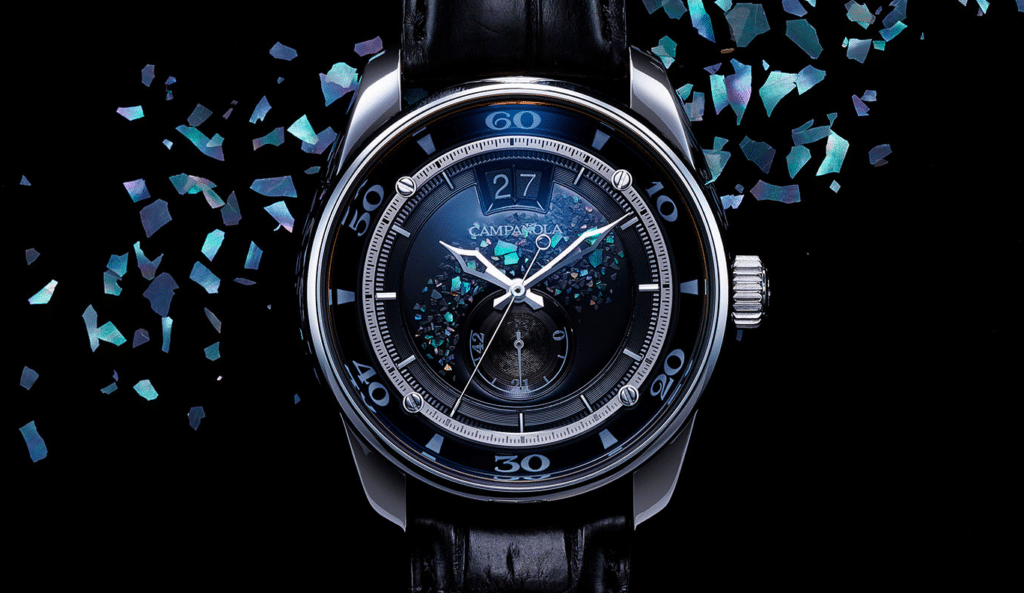
| Location: | Nishitokyo, Tokyo, Japan |
| Founding Year | 2000 |
| Popular Model Collections | Mechanical, Cosmosign |
| Design Style | Organic and avant-garde, celestial and luxury |
| Price Range: | $1500 – $6000 |
Campanola is to Citizen in the same way Grand Seiko is to Seiko – a higher-end offering that allows the company to create watches with more refined and extravagant designs, materials, and movements. One look at Campanola and you can see that they are nothing like most Citizen offerings. This sets them apart from Grand Seiko and Orient Star which still share some design DNA with their more affordable counterparts.
Dreamy dials, perpetual calendars, moon phases, and hour and minute hands that you would usually only find in haute horology pieces are all characteristics of Campanola. You will have to decide against getting a watch from The Citizen line with your hard earned dollar, which is in the same price category as Campanola but is just an upgraded Citizen with different dial materials. Therefore, what you will get with Campanola is something unique that no watch brand is doing, even outside of the Japanese market.
Orient Watches
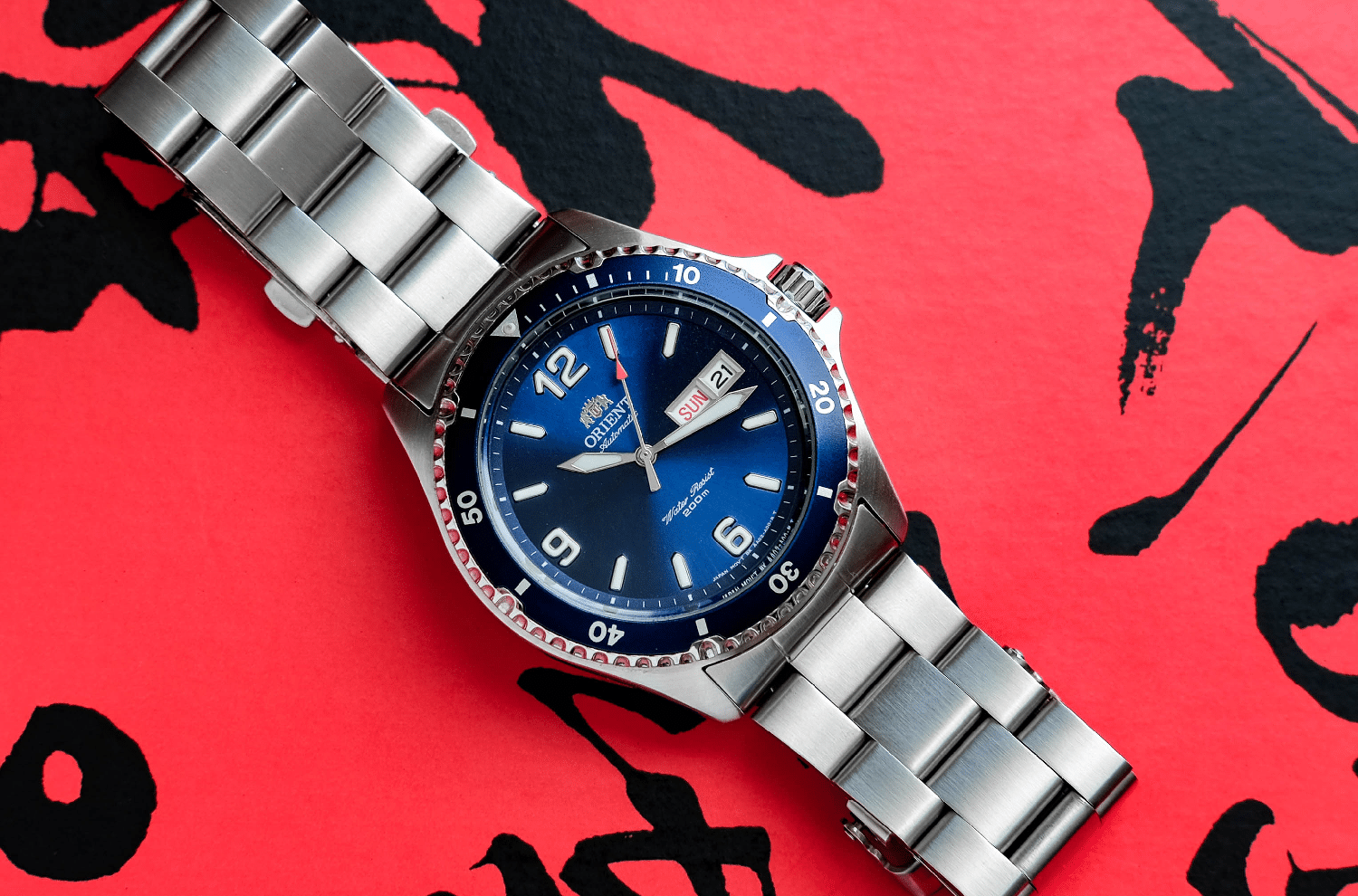
| Location: | Shinjuku, Tokyo, Japan |
| Founding Year | 1950 |
| Popular Model Collections | NEO70s, Bambino, Mako, Ray |
| Design Style | Everyday, economic tool and dress watches |
| Price Range: | $99 – $450 |
Orient, being owned by Seiko Epson Corporation, always puts the brand in the same talks as Seiko and questions surrounding this very similar group, like: Is Orient owned by Seiko? Does Orient have Seiko movements? Is Orient Seiko? They are all great questions, but simply put – no. Seiko Epson was a major company in the Seiko Group, but is neither a subsidiary nor an affiliate of Seiko Group Corporation which makes Seiko watches. So, Orient should be thought of as a competitor to Seiko, and the competition is stiff.
Today, Orient watches sneak in right under Seiko’s entry-level price point, making it a real consideration for anyone looking for a great, affordable watch. The Mako and Ray for their dive watches, the Bambino for their dress watch, and the Orient Neo 70s line for their solar chronographs all seem to trade strategically right below Seiko’s pricing. Plus, you’ll be getting an in-house automatic movement as well (for their mechanical timepieces). My first serious watch was an Orient Mako II, and to this day, it remains a great start into the hobby.
Orient Star
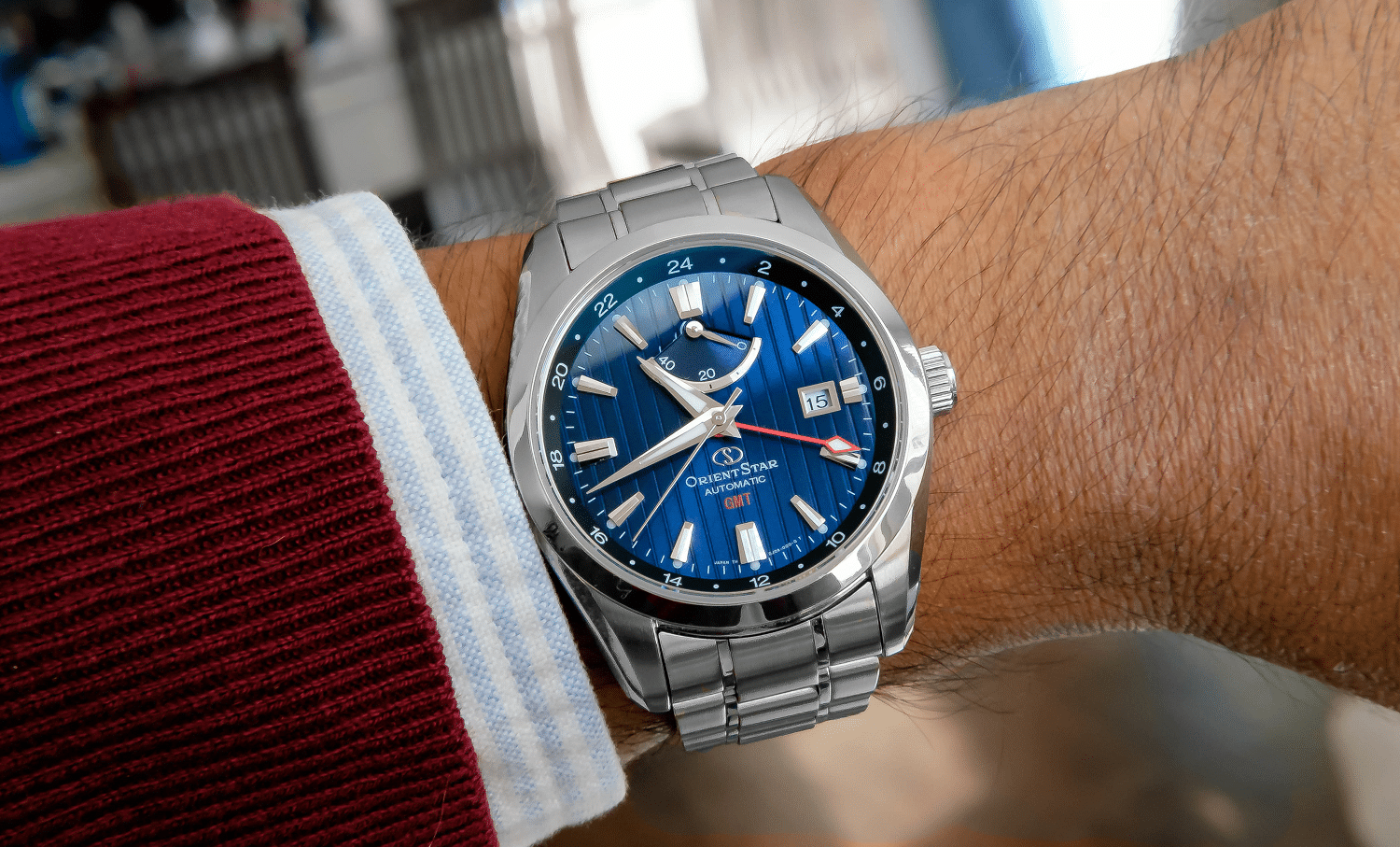
| Location: | Shinjuku, Tokyo and Yuzawa, Akita, Japan |
| Founding Year | 1951 |
| Popular Model Collections | Sport, Contemporary, Classic |
| Design Style | Upgraded daily watches featuring power reserves |
| Price Range: | $500 – $2000 |
The normal production of Orient Star may have started in 1997, but they can be looked at as the same brand as Orient and thus sharing Orient’s rich history, and success. Orient’s mission statement is: “To offer high-quality, attainable timepieces with enduring style.”, which in some cases, is not what Orient Star does with its higher price point. However, this is exactly why Orient Star needs to exist. Prices reaching as high as $1000 can’t have “Orient” slapped on the dial, but can have the “Orient Star” label due to the finer finishing, added complications, and better specifications that Orient Star delivers that Orient won’t.
Divided into Classic, Contemporary, and Sport collections, Orient Star has something for everyone. The Classic line are their dressier pieces that they keep super fun with power reserve indicators, Bregeut style hands, open-heart dials, and exhibition casebacks. Their Contemporary line are their sleek, versatile watches that remind me most of Grand Seiko because of the case finishing used. Lastly, their Sports collection is undoubtedly their tool watch segment with big, legible pilot watches and ISO certified divers available in many colorways. One thing in common with all collections is the presence of a power reserve indicator scattered throughout models which appears to be a signature for Orient Star.
Kurono Tokyo
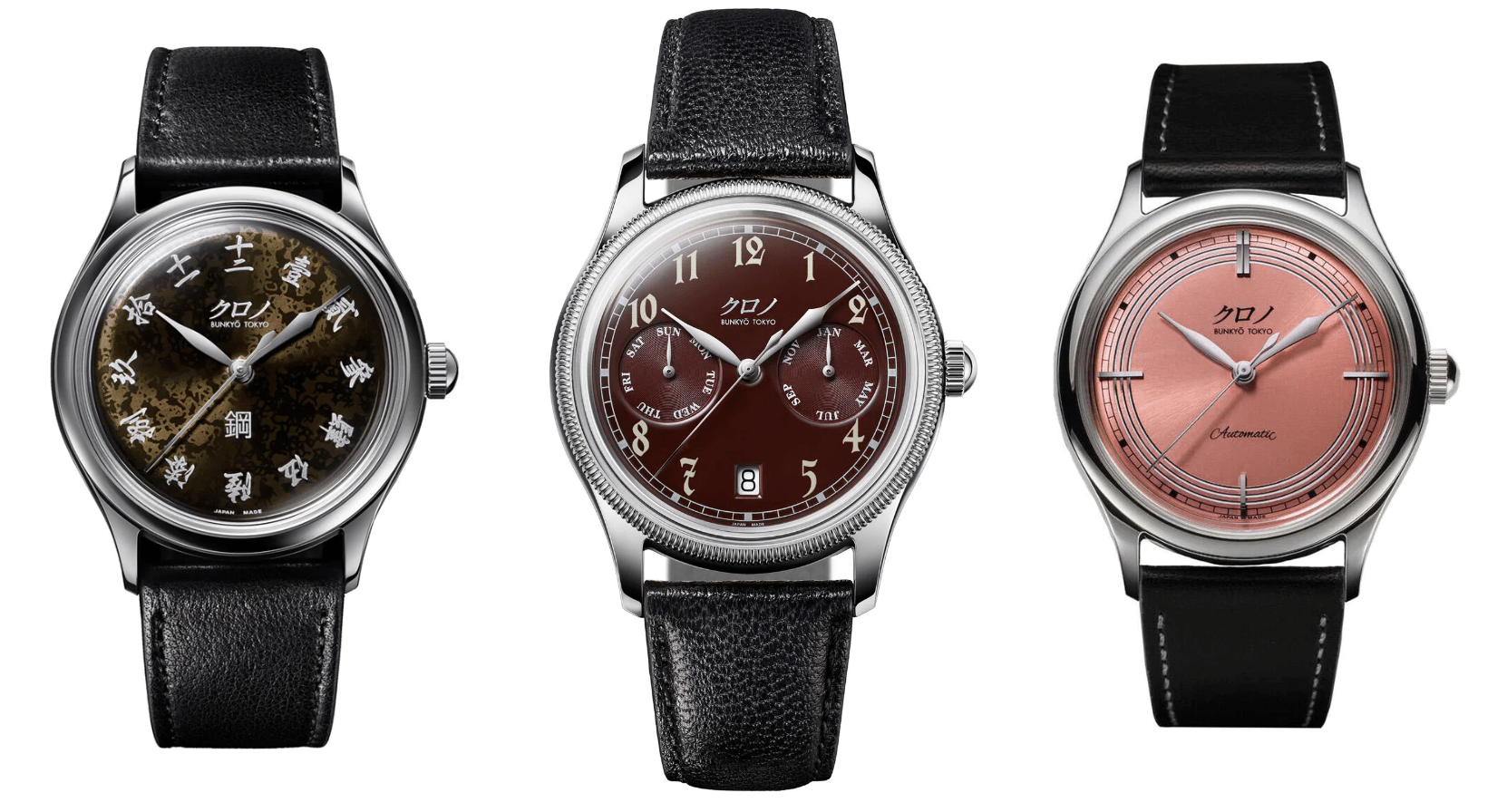
| Location: | Tokyo, Japan |
| Founding Year | 2019 |
| Popular Model Collections | Complication series, Grand series, Classic |
| Design Style | Timeless dress watches with added character |
| Price Range: | $1700 – $5000+ |
From the mind of Hajime Asaoka, comes Kurono Tokyo, a Japanese microbrand that has gotten a lot of attention as of late. It may very well be a more pedestrian version of watches that Hajime produced in his early days, but they are just as refined and imaginative. No, you won’t find a watch among Kurono Tokyo’s catalog with Japan’s first in-house tourbillon movement, (that would have been in Hajime’s earlier works in 2009), but you will find something that you wish to have on your wrist and that can be a daily wearer.
These classically proportioned wristwatches first came to the scene with the Bunkyo Yokyo in June 2019, which are 3-hand, dress pieces with only 3 lines of text (1 line being “Kurono” in Japanese calligraphy) on the dial. The brand made their next huge splash with the Chronograph 1 MK.2. This automatic chronograph powered by Seiko’s NE86, is a bicompax, sleek chronograph that displays all the qualities you’ve seen in other classic chronographs but adds something uniquely “Japan”. And, possibly their most interesting watch, the ‘Azuki’, is a complete calendar which shows month, day, and date, and is art-deco inspired. A Miyota 9122 powers the center seconds and calendar, and is rarely used – another reason to pick up a Kurono.
Minase Watches
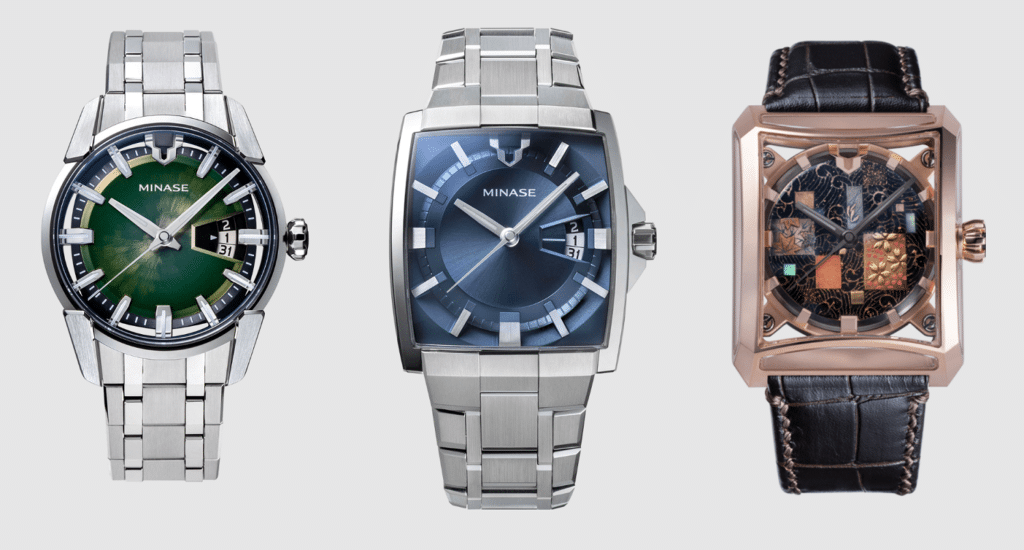
| Location: | Akita, Japan |
| Founding Year | 2005 |
| Popular Model Collections | 5 Windows, Divido, Horizon |
| Design Style | Loud, blingy, hand-finished with detailed dials |
| Price Range: | $2900 – $9000 |
One glance at Minase and you may get flashbacks to your first quartz fashion watch that you pulled off the rotating display at your run-of-the-mill department store. Yes, Minase may be loud and in your face just like those cheap watches that caught your attention, but where those watches fall short, Minase far, far exceeds.
A look on the Minase website reveals surprise after surprise. You will wonder why more people aren’t talking about the brand. Their hand-polished surfaces, altimeter dates, ETA base movements, and a 7000 year old Japanese lacquer called Urushi in which one model embeds blue shells in the black lacquer make Minase one of one. Minase offers other textured dials as well that may garner a comparison to Grand Seiko, and that isn’t the only similarity to GS. The price point of Minase looks very similar to what you might expect from Grand Seiko, so, if given the choice, what would you choose: the more household name in Grand Seiko or the gaudy with a sense of absolute refinement in Minase?
Naoya Hida
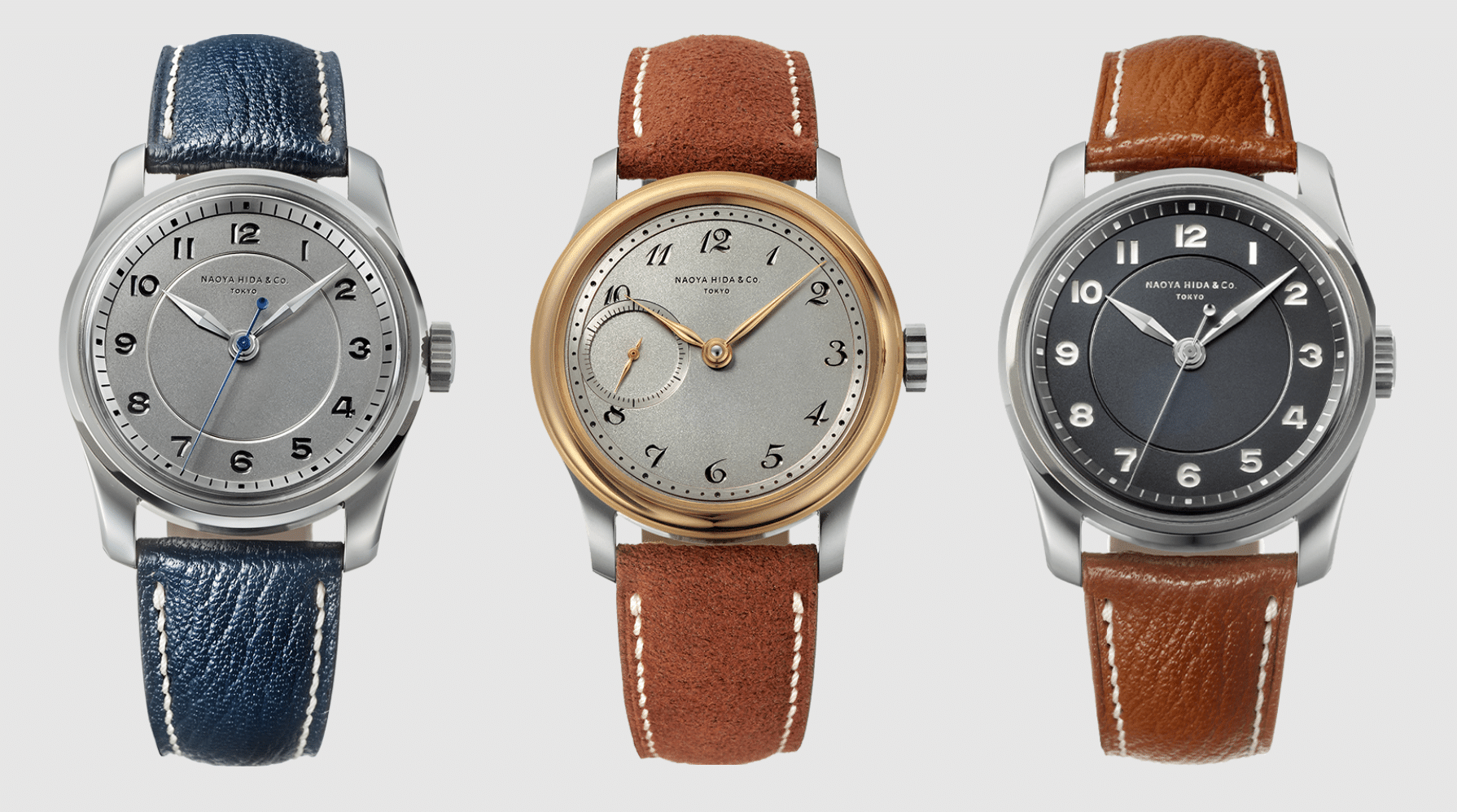
| Location: | Chou-ku, Tokyom Japan |
| Founding Year | 2018 |
| Popular Model Collections | Type 1, Type 2, and Type 3 |
| Design Style | Classic take on heritage watchmaking |
| Price Range: | $20,000+ |
You can argue that every wristwatch is a luxury item because of todays access to the time whenever you want with your phone. When that item that you don’t necessarily need costs upwards of $20,000 US dollars, it better come with a donor liver transplant, because you’ll need to calm your nerves with a few dozen drinks while you come to terms with what you just spent. But honestly, that hefty price tag makes sense coming from a small independent watch brand, if it’s: made in limited quantity, intimately handmade, and excruciatingly beautiful. And that’s what we have in Naoya Hida with their Type 1, 2, and 3.
The Founder and CEO, sharing the same name as the company, has worked for F.P Journe and Ralph Lauren Watch and Jewelry. He started NH Watch Co., Ltd. in 2018 and added an engraver and watchmaker to his team which you can clearly see represented in his neo-vintage watches. You’ll never guess that their Type 1 watch has a chronograph Valjoux 7750 base, which the team picked to use because of the perfect subdial placement at the 9 o’clock – and, you know that it is finished beautifully. Their Type 2 design is a sector dial with perfectly cylindrical baton hands that leap off the dial with their 3D effect. Lastly, the Type 3 is a moon phase in which 2 pieces of 18kt gold that make the moon and the disc smile back at you. All models are limited to 10 – 20 pieces.
Kikuchi Nakagawa
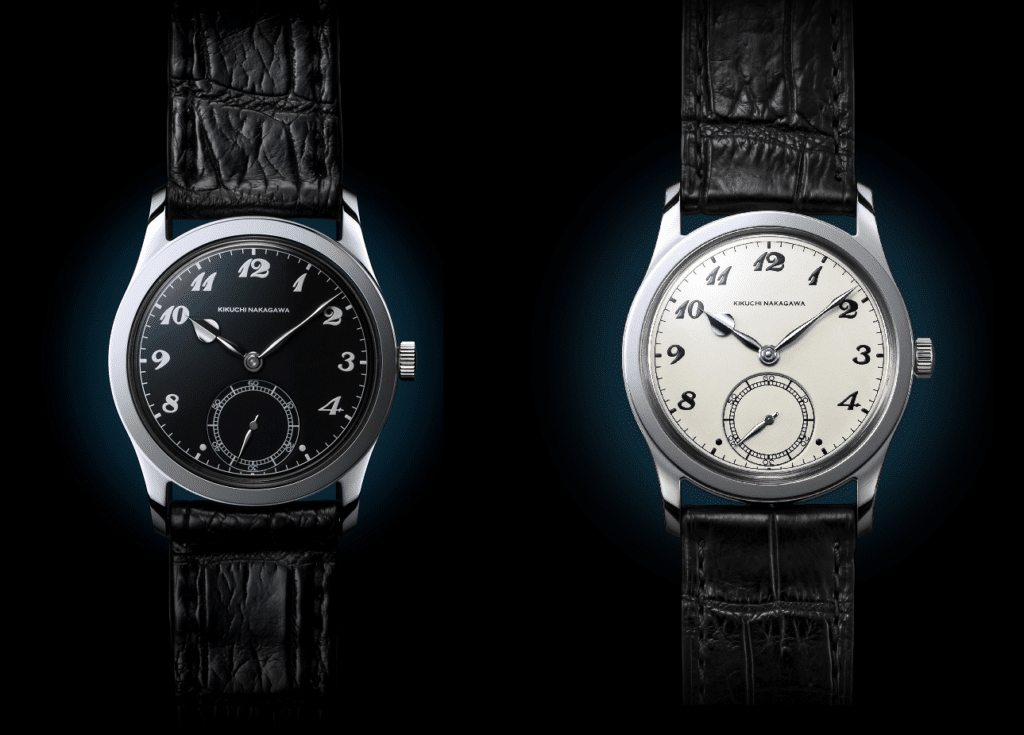
| Location: | Tokyo, Japan |
| Founding Year | 2018 |
| Popular Model Collections | Murakumo and Ichimonji |
| Design Style | Deep heritage inspired with Japanese twist |
| Price Range: | $22,000+ |
What does swordmaking, working for a Japanese watch behemoth, and helping out at a small Japanese Independent all have in common? They are the background to Tomonari Nakagawa, one half of Kikuchi Nakagawa. His partner, Yusuke KIKUCHI, while having a more white-collar background of University and a job in software, landed all the same in watchmaking by going back to school in Paris where the two met.
Currently they have two offerings which are the Murakumo and Ichimonji, and the inspiration is clear – 1930-1950s dress watches. Ichimonji translates to “straight line through the path of harmony”. Not only are the hands batons that are supremely straight without wavering, but the case being 37mm diameter and the strap being a 20mm lug width creates a straight and classic flow from the buckle on one end to the end of the strap. The Murakumo exaggerates this proportion even more with the same case size but a 22mm wide strap! The vibes are undeniably classic, and the spade hour hand is something I hope to see in the metal one day. Wait time 2+ years.

Kevin is a serial hobbyist from Chicago who leaned heavily into his watch interest in March of 2020. His small collection favors appearance and comfort, which often leads to his sword-hand Seamaster or DLC Lunar Pilot on wrist. Having other obsessions like drumming to metal music, watching MMA, and perfecting his home gym, Kevin has found the watch hobby to be both relaxing and fun, but also incredibly expansive.
Fun article. I love watches and it’s something I can’t define. I collect based on what my eyes enjoy. Over the years I have learned a fair amount about the movements, complications, and makers. I have love and admiration for some of the more expensive and renowned timepieces on the market. Unfortunately, I have to be practical about my purchases due to my “average” income. It hasn’t hampered me from buying and enjoying the selections I have made for a second (typically $200-500). It is reaffirming to hear someone else say what I have thought for years…if it makes you happy
Thanks Curtis! That price range can absolutely make a fantastic collection